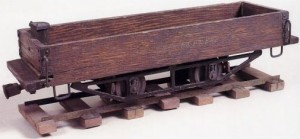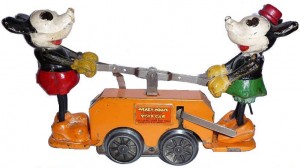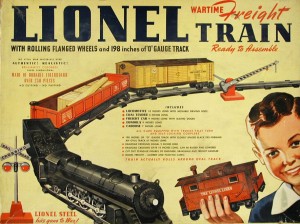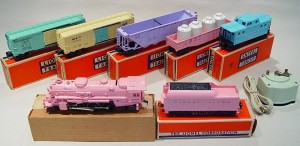The sound of the wheels rolling on metal rails, the smell of the smoke from a steam locomotive and the warm electric hum of the transformer bring back memories of Christmas and hobby times past. Lionel model trains have been an integral part of American history for fathers and sons since being introduced in 1901. Lionel wasn’t the first electric toy train but they quickly became the best. They stayed ahead of their would-be competitors by continually evolving and innovating new model trains and accessories. Lionel grew to be the largest toy brand in the world by the 1950s, enduring the Great Depression and two world wars, and is still enjoyed by today’s generation.
The Lionel Manufacturing Company was started in 1900 by Joshua Lionel Cowen, and he went on to create Lionel’s first model train in 1901, the Electric Express, which was a battery-powered cheese-box for a department store window display (G. Souter and J. Souter, Classic Lionel 16). It wasn’t originally marketed to consumers, but that quickly changed and by 1903, the Electric Express, now made of metal, was Lionel’s first complete train set, coming packaged with an unpowered car (G. Souter and J. Souter, Classic Lionel 16,19). Dennis Karwatka reported that it was in this year that Lionel also started to make a new engine, the No. 5 electric locomotive, painted to look like a locomotive that the Baltimore & Ohio Railroad had just put into service. Having this scale version of an in-service locomotive was a big success, “[starting] a craze for expensive models that continued for years” and set the direction for future design choices (Karwatka 12). Lionel continued to innovate during these years with a three rail track system, the Standard Gauge, in 1906 and an outlet powered transformer, both of which eliminated short circuits in the track. In 1915 Lionel came out with O gauge trains and a cheaper to manufacture track, which would eventually dominate the Lionel brand (Fillon). Lionel had established itself in the model train market and it looked like the best was yet to come.
America entered World War I in 1917, and Lionel remained in step with the time, releasing “… an O-gauge armored train complete with a cannon-equipped locomotive” for the children at home (Lionel sec. 1910s). Even though America didn’t use armored trains in the war, Lionel used the slogan “Bring Up the Siege Guns on Tracks! Best fun yet, boys! Now, there’s bushels of fun ahead!” as part of the armored train marketing (G. Souter and J. Souter, Lionel 33). Lionel incorporated in 1918, officially becoming a corporation and changing the company name to the Lionel Corporation. Lionel continued to gain in popularity and success and “had sold over a million … train sets by 1921” (Karwatka 12). Lionel and another competitor, American Flyer, purchased a common competitor named Ives Manufacturing in 1928 (G. Souter and J. Souter, Lionel 43) to utilize Ives’ reversing unit that would allow the model trains to travel forwards and in reverse (Lionel sec. 1920s). Lionel was doing very well with “… profits in 1929 [standing] at nearly $2.3 million …” and it looked as though they could do no wrong (G. Souter and J. Souter, Classic Toy 67). When the stock market crashed, it hit everyone very hard and Lionel was no exception, going into receivership in 1934 to avoid bankruptcy (Lionel sec. 1930s). The article “Lionel Line” in Time magazine reported in 1935 that Lionel had approached Walt Disney the previous year and negotiated the rights to make a Mickey & Minnie wind-up handcar “to scoot around Lionel tracks” (“Lionel Line”). It was an instant success, selling 235,000 handcars that winter at $1 each. In a matter of eight short months all of Lionel’s creditors were paid and the judge who presided over the receivership said, “’This was the most successful receivership in the history of this court.’” (“Lionel Line”). With the war and depression behind them, Lionel started to pick up steam again and began producing more animated accessories which, appeared in 1940, including a “No. 164 log loader, with [a] working conveyor belt” (Lionel sec. 1940s).
Some of this momentum was lost in 1942 when, America being well into World War II, “Lionel cease[d] production of electric trains and [built] compasses and compass cases for the war” (Lionel sec. 1940s). Lionel didn’t stop producing trains all together and in 1943 released a paper train set complete with paper track, locomotive, tender, boxcar, gondola, and caboose (G. Souter and J. Souter, Lionel 69). At the same time Lionel was putting out a Railroad Planning Book and Model Builder magazine so fathers and sons could plan for new model train layouts to come after the war (Lionel sec. 1940s). The paper train may not have been a lasting success, but Lionel was busy working on new concepts and ideas for locomotives and accessories to put back into production after the war was over. Mike Fillon wrote for Popular Mechanics that, in 1946, Lionel released a large collection of products, including a smoking mechanism in their steam engines. Not all their war-time innovations were successful though, such as the Lionel Electronic Set which was controlled by a new Electronic Control Unit that sent signals to receivers placed in each car on the track. This new advanced system ended up being problematic and was discontinued by 1949. That same year locomotives were being die-cast instead of the steel stamped method and injection-molded plastic was being used for rolling stock. In 1950 Lionel introduced Magne-Traction, which helped the locomotives grip the rails more, which enabled trains to go faster without flying off the track. 1953 marked the peak of Lionel’s history; they had recorded their largest profit for the year and were now the world’s largest toy manufacturer (Fillon).
Lionel was on top of the world in the mid-1950s. Although families continued setting up their Lionel train layouts at Christmas time, interest in model trains had started to decline (Fillon). Lionel made several attempts to diversify their model train line-up including a now infamous “Lady Lionel” in 1957 that featured a pastel pink locomotive and tender car to try and attract girls but they didn’t make a big impact (Doyle 51). Joshua Lionel Cowen resigned from the Board of Directors in 1958, at the age of 81 (Somonelli 72) and Lionel’s Lionel Train History webpage states that just one year later in 1959, he and his son sold their remaining share of Lionel to Roy Cohn. Through the 1960s, Lionel seemed to be just barely staying afloat and filed for bankruptcy in 1967, just two years after Joshua Lionel Cowen passed away. In 1969 Lionel licensed its name to General Mills who, by 1973, put Lionel into one of its subsidiaries named Fundimensions. They went on to put out new trains and reproductions that were as good if not better than the originals. In 1977 Walt Disney and the Lionel brand teamed up again on a train set named the Mickey Mouse Express, which revitalized the Lionel brand in the minds of consumers for a short time. With profits and interest in model trains continuing to decline, General Mills was looking to unload its Lionel assets by 1986. They sold the brand to Richard Kughn, a real estate developer, who established the brand under a new name, Lionel Trains (Lionel sec. 1950s, sec. 1960s, sec. 1970s, sec. 1980s). Richard J. Kughn marked the first owner of Lionel since Joshua Lionel Cowen left that was a real model train enthusiast and owned “one of the country’s largest toy train collections” (Schleicher 35). Lionel released a new audio system called Railsounds™ in 1989, showing renewed vigor as a company. In 1992 Lionel Trains teamed up with another model train enthusiast, musician Neil Young, to create Liontech. In 1994 a new control system called TrainMaster™ brought back the functionality of the earlier 1946 Lionel Electronic Set (Lionel sec. 1990s). Lionel was sold in 1995 by Richard Kughn and is now Lionel LLC. As a sign of Lionel returning to its former glory they published the first fully illustrated catalog of their products in over 30 years in 1996 and continue to publish one annually (Fillon).
Lionel catalogs, chock-full of new model train layouts, freight trains, passenger cars and animated accessories, continue to fill the holiday wish lists of American children and adults alike. Lionel model trains have been around for over 100 years and have endured war, depression and uncertainty of ownership, a testament to their commitment to model train enthusiasts and America’s love of Lionel. Although ownership of the brand changed hands many times in the second half of the last century, their product quality never faltered and Lionel continues to make incredible model trains today. The Lionel brand of model trains is as strong now as it was through the 1950s and will be a part of American history into the twenty first century. Future generations can count on Lionel model trains to inspire their imaginations.
Works Cited
Doyle, David. Standard Catalog of Lionel Trains 1945-1969 2nd Edition. Iola: krause, 2006. Google Book Search. Web. 25 Feb. 2012
Fillon, Mike. “Lionel Trains.” Popular Mechanics 178.4 (2001): n. pag. Academic Search Complete. Web. 25 Feb. 2012
Karwatka, Dennis. “Joshua Lionel Cowen and Lionel Model Trains.” Tech Directions 66.4 (2006): 12. Academic Search Complete. Web. 25 Feb. 2012
“Lionel Line.” Time 25.5 (1935): 66. Academic Search Complete. Web. 25 Feb. 2012.
Lionel Train History, Lionel Past and Present. Lionel, 2012. Web. 25 Feb. 2012
Schleicher, Robert. Modern Lionel Trains. St. Paul: MBI, 2003. Google Book Search. Web. 25 Feb. 2012
Somonelli, Yolanda M. “The Mighty Blue Comet…and The Man Who Immortalized It!” Antiques & Collecting Magazine 104.4 (1999): 20. MasterFILE Premier. Web. 25 Feb. 2012
G. Souter and J. Souter, Gerry, and Janet G. Souter and J. Souter. Classic Lionel Trains, 1900-1969. St. Paul: MBI, 2002. Google Book Search. Web. 25 Feb. 2012
—. Classic Toy Trains. St. Paul: MBI, 2002. Google Book Search. Web. 25 Feb. 2012
—. Lionel: America’s Favorite Toy Trains. St. Paul: MBI, 2000. Google Book Search. Web. 25 Feb. 2012




Dear Mr. Sonntag,
I was wondering if I could use your photo of Lionel’s Electric Express and the Mickey Mouse Hand car for an article I’m writing on the history of Lionel. I’ll be sure to credit you and your page as your source however you would like.
Thanks!
John
Hi John, I’m glad it looks like you enjoyed the article. I’m excited to read your upcoming piece and would love to help or be a reference for you. I have emailed you directly to provide what help I can. Thanks!